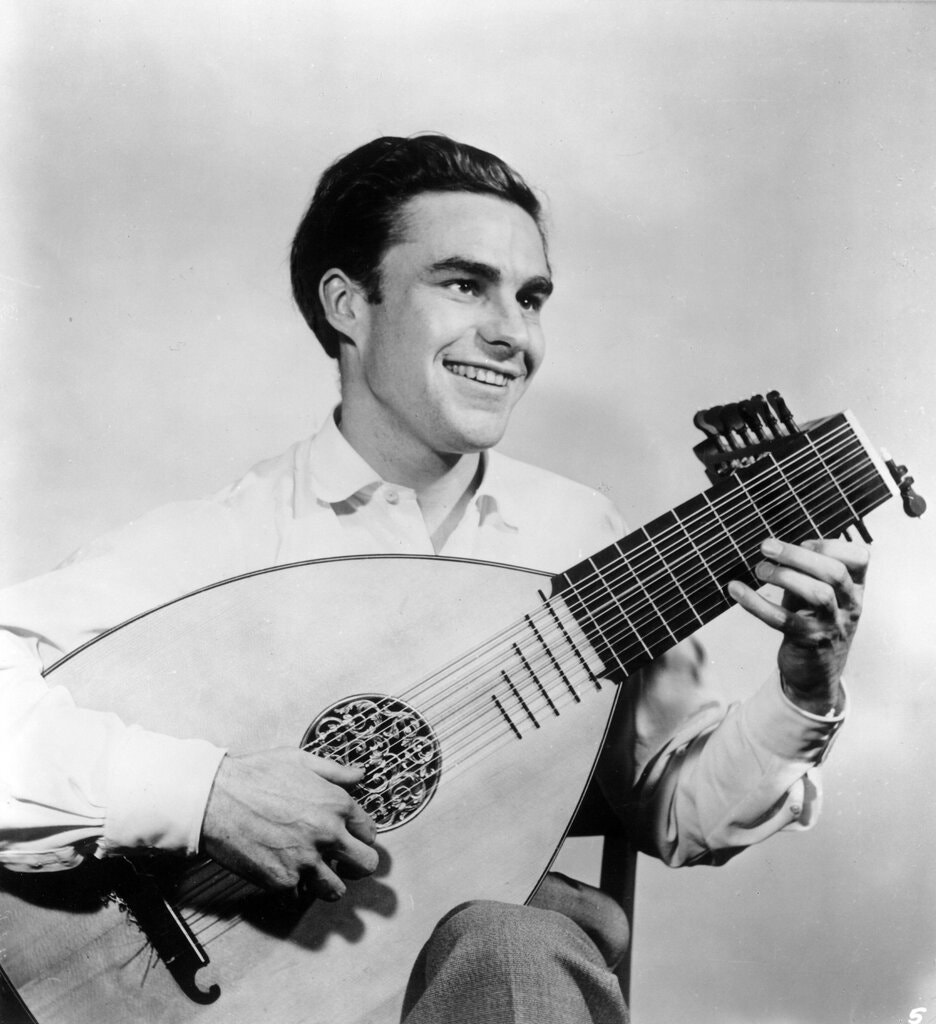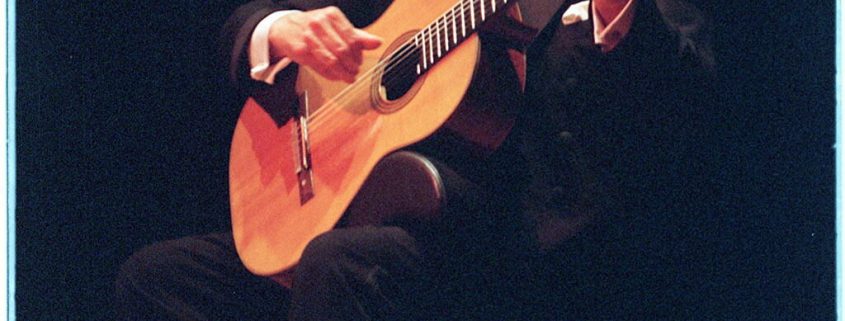JULIAN BREAM WAS THE SOUND OF MY SCHOOL DAYS.
JULIAN BREAM WAS THE SOUND OF MY SCHOOL DAYS.
By Norman Warwick
Today´s cover photograph above, by Rahav Segev for The New York Times, shows legendary guitarist Julian Bream performing at Alice Tully Hall in New York in 1997. He made his American debut in 1958 at Town Hall in Manhattan.

Michael Ochs Archives via Getty Images
Allan Kozin, (with additional reporting by Julia Carmel) composed an obituary in The New York Times for Bream who sadly passed away on Friday 14th August at his home in Wiltshire, England, at the age of 87.
Kozin felt it could be argued that Bream, even more than Andrés Segovia, established the guitar’s credibility as a serious solo instrument. After all, Julian Bream was an English musician who pushed the guitar beyond its Spanish roots and expanded its range by commissioning dozens of works from major composers. He also played a crucial role in reviving the lute as a modern concert instrument.
Bream is described in this obituary as the most eloquent guitarist of the generation that came of age soon after Andrés Segovia carved out a place for the guitar in the mainstream concert world. Julian Bream updated the technical standard of classical guitar playing and replaced the Romantic, rubato-heavy phrasing that Segovia preferred with a more modern style. And he undertook a significant renovation of the repertory.
Segovia, a Spaniard, perhaps unsurprisingly devoted himself largely to music that naturally emphasized the guitar’s Spanish and Latin American roots.
Mr. Bream, however, showed that the instrument was equally suited to German, French and English works and to some of the thorny contemporary styles that the more conservative Segovia avoided.
Although he did not simply ignore the Spanish and Latin repertory, he created an alternative and just as durable one through research, transcription and commissioning. He was, says Kozin, the first to revive major works by Fernando Sor of Spain and Mauro Giuliani of Italy, two important 19th-century guitarist-composers. His transcriptions included Bach suites and Scarlatti sonatas, as well as works by Purcell, Cimarosa, Diabelli and Schubert.
The large collection of pieces he commissioned, many of which he also recorded, are likely to be his most enduring legacy. The scores written for him that are now staples of the guitar literature include Benjamin Britten’s Nocturnal (1963); William Walton’s Five Bagatelles (1971); and concertos by Malcolm Arnold (1959) and Richard Rodney Bennett (1970). Hans Werner Henze, Peter Maxwell Davies, Michael Tippett and Toru Takemitsu also wrote works for him
´I do think there is a valid reason that Segovia commissioned the composers he did,´ Mr. Bream said in a 1983 interview with The New York Times. ´He was very much a pioneer, and what he wanted was a very listenable repertory. But I’m interested in different aspects of the guitar, and of music. And while I think it would have worried Segovia that certain works might not go down too well, as often happens with modern music, that doesn’t worry me´.

Michael Ochs Archives via Getty Images
Some photographs accompanying this piece, by the way, are part of the Michael Ochs Archive, brother of the late folk singer / Elvis Wannabe who wrote the beautiful There But For Fortune. Its a small world from rock to folk to classical.
Mr. Bream took up the Renaissance lute in 1950 in order to play works that were written for it by Elizabethan composers. Credit…Michael Ochs Archives, via Getty Images Mr. Bream also had an antiquarian streak that made him an important figure in th e modern revival of the lute. He took up the Renaissance lute in 1950 in order to play works that were written for it by Morley, Dowland and other Elizabethan composers.
He was not the first to do so, but his predecessors had sat on the scholarly edge of the early music world.
Mr. Bream, by contrast, hoped to make the lute as popular as the guitar, and he set about searching libraries for little-known works that might illuminate the instrument’s expressive strengths.
The Julian Bream Consort, a string, wind and lute ensemble, was formed in 1959 to perform and record Elizabethan ensemble music. At recitals, he often played the lute before the intermission and the guitar in the second half of the program.
Mr. Bream’s success as a lutenist inspired a generation of young musicians, including Paul O’Dette, Stephen Stubbs and Hopkinson Smith, to set aside the modern guitar and concentrate on the lute and other early stringed instruments. In the early 1980s, Mr. Bream followed their lead in taking up early forms of the guitar — the Spanish vihuela and the Baroque guitar — while preparing his video series Guitarra!, which traces the guitar’s history.
It is a measure of the man, surely, that when research by younger lutenists suggested that Mr. Bream’s lute technique was inauthentic, he stopped playing the instrument publicly so that he could catch up with the latest scholarship. By the time he began giving lute performances again, he had not only revised his technique but had also taken up the larger Baroque lute.
His parents, to whom he was born in London on July 15, 1933, were Henry and Violet Jessie (Wright) Bream. His father was a commercial artist, his mother a homemaker, who divorced when he was 14.
Julian played the piano and the cello as a child but was inspired to take up the guitar after hearing the virtuoso jazz guitarist Django Reinhardt. His father, who was a keen amateur jazz guitarist, gave him his first lessons, and when Julian heard some Segovia recordings in the mid-1940s, he decided to study classical guitar music.
´When my father saw that I was interested in following such a career,´ Mr. Bream was quoted as saying to Tony Palmer, his 1982 biographer of Life On The Road, ´he had many reservations. His feeling was that there was no chance to earn a livelihood unless I played jazz or something similar.
And to prove it he did say to me one day that if you take into account the whole population of the world, and given that there’s only one world famous classical guitarist so far, the chance of success for a second guitarist must be very slender. But that remark made me all the more doggedly persistent.´
Such persistence proved necessary. At his audition for admission to the Royal College of Music in London, Mr. Bream played the guitar first, even though the instrument was not taught there, and then the piano. The school admitted him as a pianist, cellist and composition student, and he was ´advised´ not to bring his guitar into the building.
But because he was giving late-night performances and playing for film soundtracks to earn money, he brought his guitar to the college anyway. When word got around that he could be heard playing Bach on it in one of the practice rooms, the school’s director asked him again to leave the guitar at home.
Mr. Bream left the school instead !
After over three years in the army, Mr. Bream tried to establish his career in earnest. He continued playing for film soundtracks and in the pit bands for radio plays, as well as an accompanist for singers on BBC programs. He also began giving radio concerts on the lute.
This is a salient point for all aspirant musicians and creative artists in any genre. Narrow focus is vital but broaden your fields, hoine you craft and demonstrate your versatility in, and understanding of, other fields and you will never spend long periods of unemployment,

Mr. Bream, shown right, with the pianist and composer Richard Rodney Bennett, left, and the conductor Andre Previn (in a 1970.photograph credited to Evening Standard/Hulton Archive, via Getty Images) made his London debut performance at Wigmore Hall in 1951 and immediately toured England. His first continental concerts followed in Switzerland in 1954, and he made his American debut in 1958, at Town Hall in New York. Thereafter, he toured annually through the 1990s, mostly in Europe and the United States.
An automobile accident in 1984, in which he broke his right elbow, required reconstructive surgery that limited his bending of the arm.
He had his surgeon set it in the optimal position for plucking guitar strings, and after relearning his technique to account for the loss in flexibility, he continued to perform and record.
His final formal recital was in Norwich, England, on May 6, 2002, but he continued to play privately, occasionally giving recitals at churches near his home until 2011, when injuries he sustained afterbeing knocked to the ground by a neighbour’s dog playing impossible.
Mr. Bream’s honours included the MBE in 1964, Commander of the British Empire in 1985 and the Villa-Lobos Gold Medal (he gave the world premiere of the Villa-Lobos Guitar Concerto) in 1976.
He married Margaret Williamson in 1968. After their divorce, he married Isabel Sanchez in 1980. That marriage also ended in divorce. Mr. Bream is survived by his sister, Janice, and his brother Anthony, an artist. Their youngest sibling, Paul, died in 2006.

Eulogist Allan Kozin also offered details of Mr. Bream´s recordings for Westminster, Decca and EMI Classics in the 1990s, whilst acknowledging that Bream was ´mainly with RCA Records´. Starting in 1959, he recorded nearly 40 discs for the label, covering a vast array of the lute and guitar repertory. In 2013, to celebrate Mr. Bream’s 80th birthday, Sony Classical (which had acquired RCA Red Seal) issued a boxed set with all the RCA discs, as well as two DVDs offering a documentary film and television appearances.
Mr. Bream was ´fussy´ about sound, preferring to record late at night in an empty chapel near his home. Something of a perfectionist by nature, he nevertheless observed that modern recording techniques could not match the sound he heard on the old shellac discs of his childhood, played on a windup gramophone with a large horn and thorn needles.
´What do I think of digital recording?´ he once mused at a cocktail party in New York. ´Well, it’s all right. But those old thorn needles, now, that was a sound.´




Leave a Reply
Want to join the discussion?Feel free to contribute!